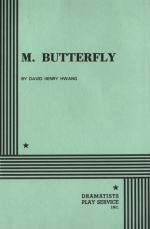|
This section contains 5,411 words (approx. 19 pages at 300 words per page) |

|
SOURCE: Cooperman, Robert. “New Theatrical Statements: Asian-Western Mergers in the Early Plays of David Henry Hwang.” In Staging Difference: Cultural Pluralism in American Theatre and Drama, edited by Marc Maufort, pp. 201-13. New York: Peter Lang, 1995.
In the following essay, Cooperman asserts that, while M. Butterfly highlights the disparities in East-West cultures, his earlier plays—FOB, The Dance and the Railroad, Family Devotions, The House of Sleeping Beauties, and The Sound of a Voice—are culturally balanced and optimistic of East-West blending. Hwang not only merges cultures in the storylines in these early works, Cooperman argues, but also experiments with a mixture of Western theatrical techniques, Chinese opera and theater, and Japanese Noh theatrical styles.
I
Arguably the most important play in terms of challenging the political/social/cultural identities of the West over the last decade is David Henry Hwang's award-winning M. Butterfly (1988). Aside from being good...
|
This section contains 5,411 words (approx. 19 pages at 300 words per page) |

|


